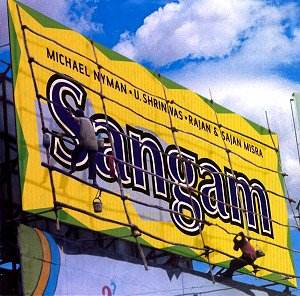Sangam is not Michael Nyman's first musical
encounter with Indian music (his second string quartet holds that distinction)
but it is a fully realised vision of what can be achieved when two traditions
meet, learn from and stimulate each other. There are two main pieces
here, the first being Three Ways of Describing Rain, a collaboration
with the great Khayal singers, the Misra Brothers. On his trips to India
to research and prepare for this project, Nyman met them in their home
city of Benares (the sacred site on the Ganges where Hindus go to bathe
in the holy waters). Unsurprisingly there is something rather numinous
in the music that they produced together, with the Nyman Band playing
a greater proportion of restrained and slow music as accompaniment to
the soulful vocal musings of the Misras; one of the sections is even
titled Meditation and this track, after a quiet opening couple
of minutes, really takes flight, with the Nyman Band and tabla player
Sanju Sahai complementing the singers perfectly. In terms of quality,
though not necessarily similarity of style or effect, the vocals are
on a par with, say, those of Nusrat Fateh Ali Khan, the late, great
Pakistani Qawwali singer, in his collaborations with Michael Brook.
In the booklet notes, Nyman is quoted as "wanting to avoid musical tourism"
and I am happy to report that he has.
My favourite piece on the disc is the thirty minute
plus Samitha, a co-composition/improvisation with the mandolin
player U. Shrinivas, which is in effect a set of "variations" on a "Nyman
pentatonic bass riff" which turns into almost a concerto for the soloist.
This, as with the Misra pieces, is in the best tradition of Western/Indian
crossover - I am put particularly in mind of two classic ECM discs -
Zakir Hussain's Making Music and Shankar's Song For Everyone.
The former featured John McLaughlin (incidentally, Shrinivas has also
worked with him in Remembering Shakti, and also recorded with the aforementioned
Brook!) and both of them Jan Garbarek. Here are two European musicians
totally in touch with the musical river that flows from the far east
through the Indian subcontinent and the Balkans/Hungary to places like
Norway and the Celtic fringes. That said, the extended opening meditation
of Samitha, which features mainly U. Shrinivas playing solo,
reminds me more of a beatific free jazz/ambient exemplified by Harold
Budd's Pavilion of Dreams (featuring the haunting saxophone of
Marion Brown) and Pharaoh Sanders' Peace in Essaouria. When the
Nyman Band kicks in fully after about five minutes we are treated to
some exhilarating and wonderfully melodic music, often making clear
the similarities between Indian music and Western folk music (at one
point there is a section highly reminiscent of the "flowers of the forest"
part of The Piano Concerto) and at times almost coming across
like an Indian MGV. There are brief interludes/lulls in which
Shrinivas gets the stage almost to himself again and the whole piece
is an organic and highly satisfying listen.
With this release, and the recent Facing Goya,
it is apparent that Michael Nyman is at the top of his game at present,
producing challenging, mature but also highly accessible music, looking
in places which others might pass by for ideas and inspiration. Sangam
avoids the normal pitfalls of "world music crossovers" by its sheer
quality and the obvious thought and preparation, not to mention inspiration,
that lie behind it. Highly recommended.
Neil Horner
